Olive-backed Sunbird
Latin: Cinnyris jugularis (Nectarina jugularis)
Family: Nectariniidae
Indonesian: Burung-madu seriganti
Size: 11 cm
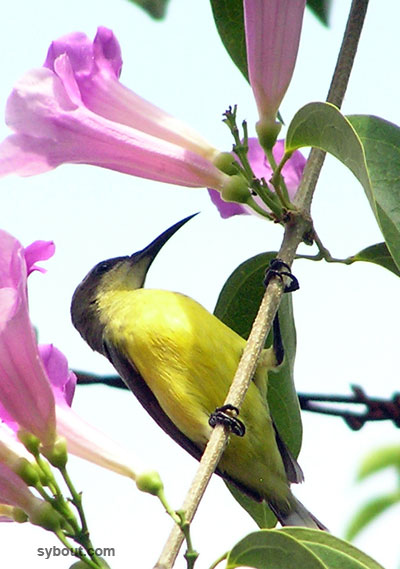
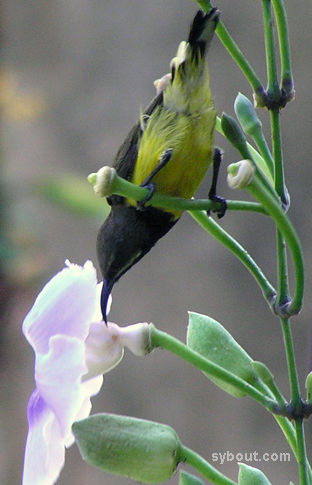
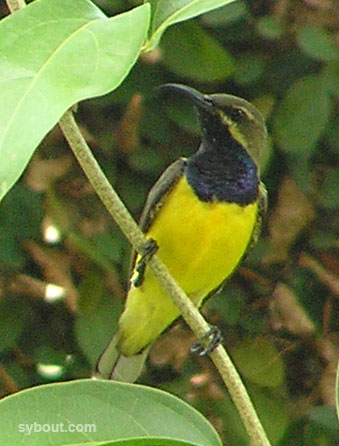
Olive-backed Sunbirds are regular visitors of my garden. They usually come for the nectar
in the flowers of the Garlic Vine and the Trumpet Vine. As the Trumpet Vine grows above our terrace and the birds are
not that shy, it is easy to observe their behaviour and appearance.
Both male and female have an olive-green back and yellow breast. The
male is distinguished by its dark purple-blue throat which looks black
without the right light fall.
An important part of the Sunbird's diet is nectar. I always thought
that the long beak of these birds is used to enter trumpet shaped
flowers from the front. In fact the bird gets its nectar in an
easier way: it just makes a hole near the basis of the flower.
There have been two attempts for nesting by Sunbirds in my garden. Unfortunately none
was successful. The first nest was destroyed by heavy wind, the
second by unexpected rain in the dry season falling exactly from the
roof above it. The nest is a rough woven hanging structure with the
entrance at the side. In the cases mentioned above the nests were
made in a shrub about 1.5 meter above the ground. One or two eggs
per nest seems to be normal.
Lemon-bellied White-eye
Latin: Zosterops chloris
Family: Zosteropidae
English: Lemon-bellied White-eye. Yellow bellied White-eye
Indonesian: Kacamata laut
Size: 11-12 cm.
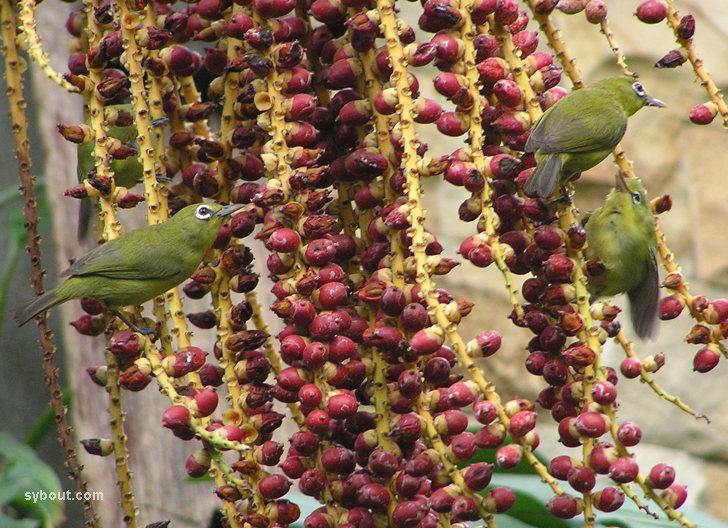
There are several Macarthur Palms in my garden of which most of the time there is at least
one tree bearing ripe fruits. Because of this there are all year
round White-eyes visiting. It often looks like these birds together
with Bulbuls (see below) do not have much else on their menu than
these palm fruits.
The White-eyes are easy to recognize by the small white feathers forming a ring around their eyes. In Indonesian their name is "spectacle bird" (Burung kacamata). This specific species is called Burung kacamata laut in Indonesian. 'Laut' meaning sea, tells us that the birds are found in coastal areas. So, with Makassar being a coastal town, I guess there is nothing special in having this bird species visiting my garden.
White-eyes are too small to take whole fruits from the Macarthur Palm. They just pick small pieces until the a fruit is finished or drops from the tree. When there are young, these follow the parents with trembling wings, begging for food all the time. The young have as well a white ring around the eyes. The main difference with their parents is that feathers are more fluffy and exposed sides of their bill.
Eurasian Tree Sparrow
Latin: Passer montanus
Family: Passeridae
Indonesian: Burung gereja erasia
Size: 14 cm.
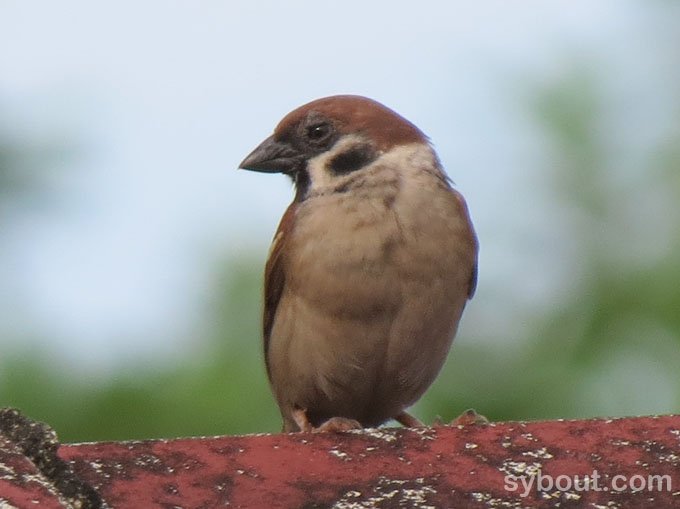
In the higher part of my
garden lives a group of Tree Sparrows. They visit the top of the mango tree, the roof
and the TV antenna. For some reason they never visit the lower
levels of the garden. This must mean that they can find enough food elsewhere.
Tree Sparrows are introduced in Sulawesi. Probably they came
here in captivity from other parts of the world.
The birds have
most of the time nests under the roof tiles of the house. It is
a big mystery for me how they and their young can survive there. Under
the roof tiles is a metal layer the avoid leakage. With the sun
hitting the tiles the temperature in the space in between must be
over 500 C during the daytime. It seems they just like
it.
Savana Nightjar
Latin: Caprimulgus affinis
Family: Caprimulgidae
Indonesian: Cabak kota
Size: about 25 cm
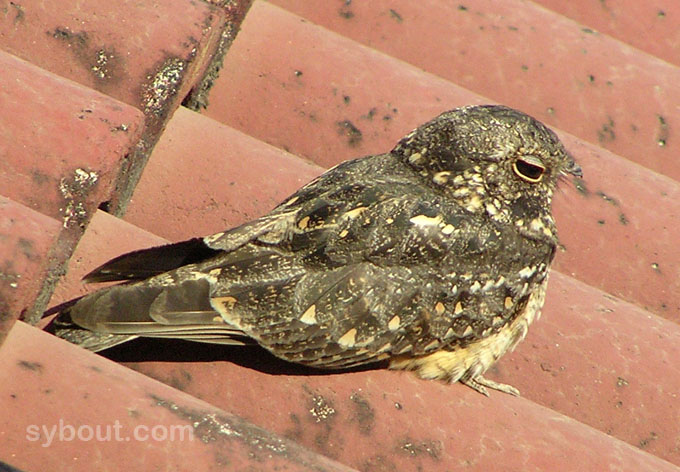
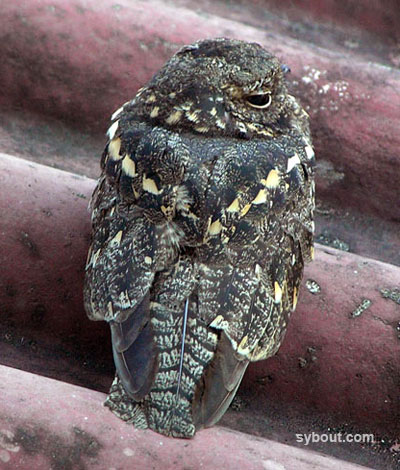
The photo's on the right are really rare. One morning these nightjars
were resting in a shady place on the lower roof of the
house. They were just sitting there, like waiting for something. Not
long after the climbing sun hit their place they were gone. Never
after I spotted the birds sitting on the roof again.
Nightjars are common in and around Makassar.
Usually you hear the bird's call not long after sunset. Their
typical 'tsweeek' tells you there are one or more of them flying
around. Their wings are relatively long and moving fast and now and
then come to a standstill for short gliding. Often the
birds make unexpected moves, obviously to catch an insect.
In the photos the nightjar's bill is difficult to see. In fact
it is very wide (for 'scooping' insects during the flight), but has
only a small part that sticks out. The beak extends up to under the
eye.
It seems the birds are most active in the hours just after sunset and just
before sunrise, but can be heard as well during other hours of the
night. After sunrise they are gone again. Maybe sitting on somebody
else's roof that is shady all day long?
Sooty-headed Bulbul
Latin: Pycnonotus aurigaster
Family: Pycnonotidae
Indonesian: Cucak kutilang, Kutilang
Size: 20 cm
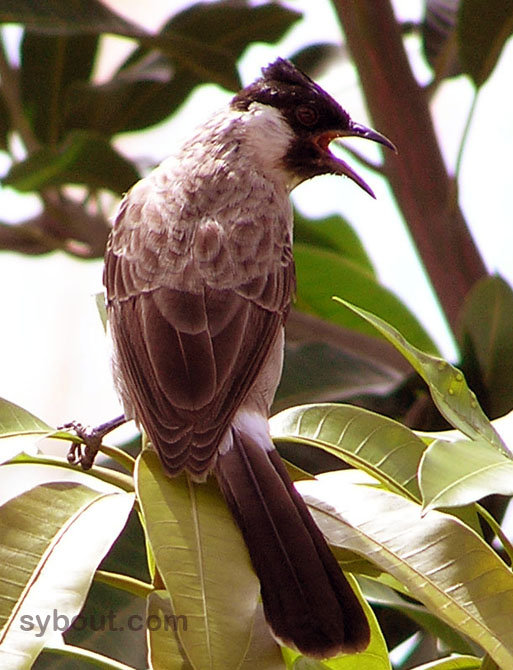
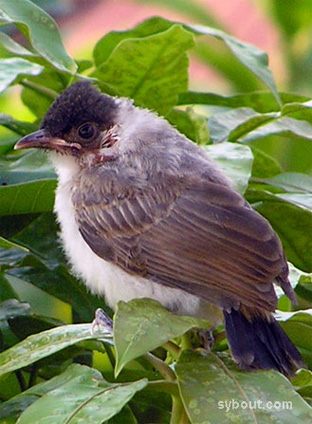
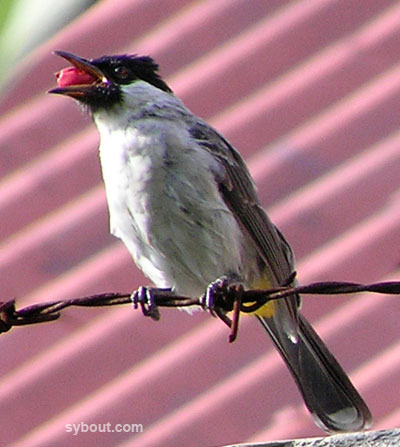
Before sunrise, with the first signs of a new day beginning, the
singing of the Bulbuls take an important part in bird sounds around
my house. In the daytime they fly in groups moving between roof and
tree tops until they think it is time to eat again. The MacArthur Palms in my garden are often visited. The birds seem to follow the
same pattern all the time: one fruit is eaten on the spot, after
that one is taken away to be eaten in an other place. If the much
smaller White-eyes happen to be around, they are chased away from
the fruits.
The Sooty-headed
Bulbul is a very common bird in Makassar. If most parts of town with
high trees you can see them flying around in groups. Actually the
bird has no origins in Sulawesi. The birds escaped from captivity
and seem to have increased to a large number.
Yellow-vented Bulbul
Latin: Pycnonotus goiavier
Family: Pycnonotidae
Indonesian: Mebah Cerukcuk
Size: 20 cm
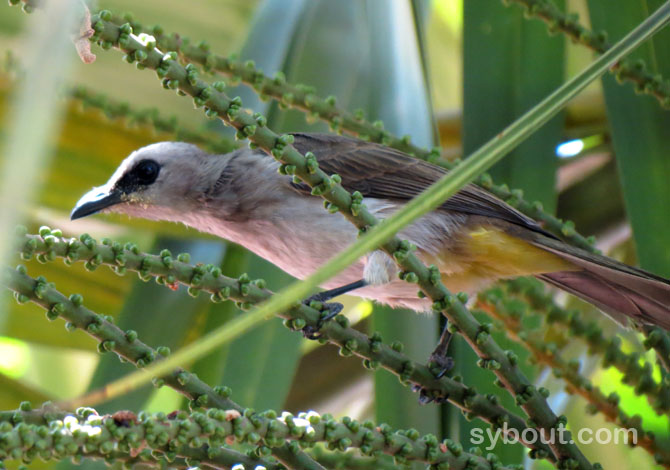
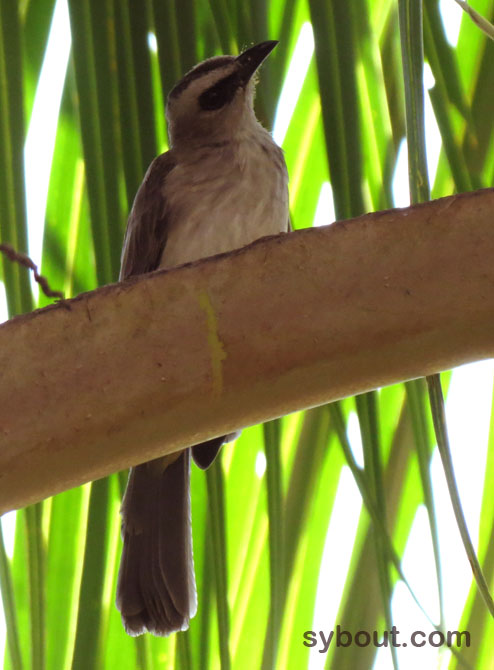
Compaired with the Sooty-headed Bulbul (see above here) the Yellow-vented Bulbul is a less common guest in my garden. At first sight these two species might
look rather similar, but when you watch their heads closely, you will notice the differences. The Yellow-vented Bulbul has a broad white eyebrow and does not have a black throat.
Like its Sooty-headed cousin the Yellow-vented Bulbul has been introduced in South Sulawesi.
Sulawesi (Barn) Owl
Latin: Tyto Rosenbergii
Family: Tytonidae
English: Sulawesi (Barn) Owl, Celebes Barn Owl
Indonesian: Serak Sulawesi
Size: 43 - 46 cm
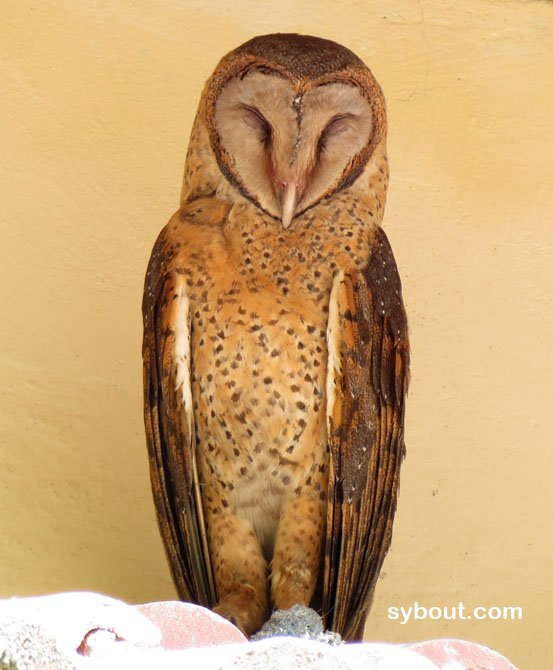
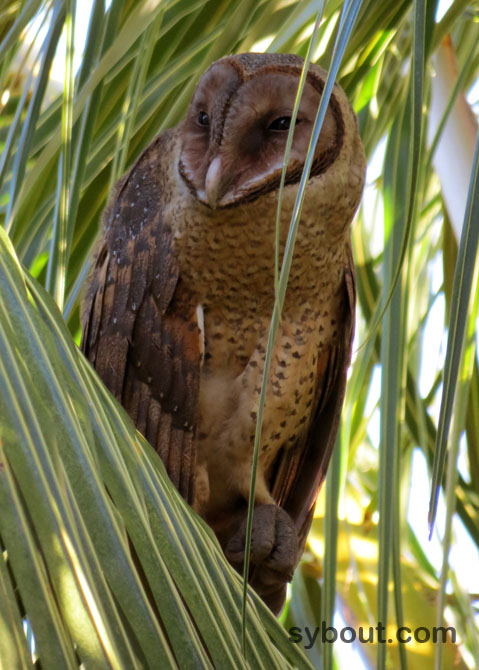
The first time a Sulawesi Barn Owl
visited my house, one of the children shouted in the early evening: "there is a small monkey flying above our house". She clearly was confused to see a bird
not known to her that had its eyes in front of its head.
The Sulawesi Barn Owl is endemic to Sulawesi and is considerably
larger that its relative Tyto alba (Barn Owl, 35 cm) which is
spread over many
parts of the world, including Java and some other Indonesian
islands.
In the bird guides I consulted the habitat of the Tyto Rosenbergii is described as open rural area, coconut
plantations and forest edges.
Several sighting in Makassar prove
that this species is a rather common bird in town and has either
adapted to this environment, or has always been living here. The
biggest surprise was to see this bird one evening sitting
above the busy traffic on a lamp post at Pantai Losari (Makassar
seaside).
The Sulawesi Barn Owl is like other owls active at night and usually rests in the day time in a shady place in a tree, or
in buildings. It makes its nest in protected places like buildings and caves.
From the pellets dropped
by this bird in my garden it looks like its food exists of rats
only. This probably means that the species' diet is similar with
that of the Tyto alba and in general exists of rodents. It means as well that it is a very useful bird that helps to control the rat population.
White-breasted Wood-Swallow
Latin: Artamus leucorhynchus
Family: Corvidae
Indonesian: Kekep babi
Size: 19 cm
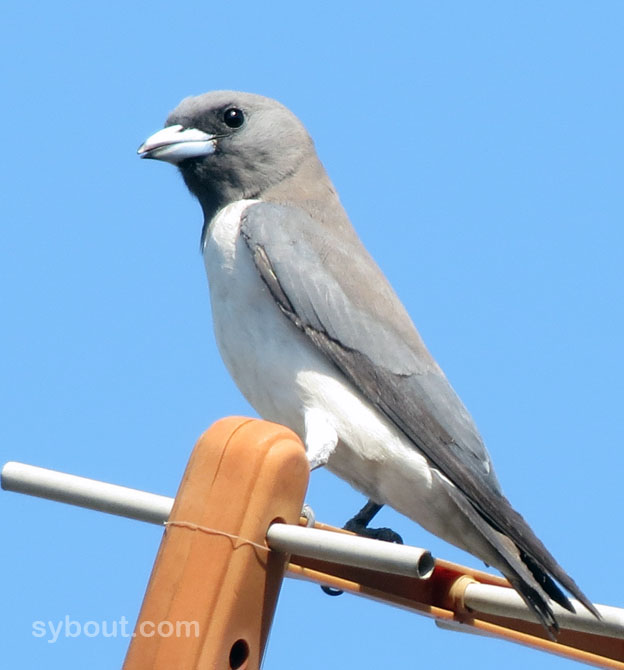
Sometimes I find a bird species around the house that I do not know yet.
The bird in the picture above was sitting one day on the TV antenna. Its head was moving in all
directions continuously, probably in search of insects. Sometimes it
flew to catch something and came immediately back again to the
antenna.
If I can make some clear photo's of new visitors I usually can find the species with the
help of a bird guide. Without photos the bird often has flown before
I can note enough details. A search in my bird guide made me first
think that the new guest was a Cuckoo-shrike. But these birds seem only to live in mountain
forests. A better look at the pictures told me that the
Cuckoo-shrike has a far longer tail. The Swallow-like flight of the
visiting bird finally convinced me that I had to look at the members
of a different group of birds. That's how I found it to be a
White-breasted Wood-Swallow.
The Wood-Swallow became a regular
visitor of the antenna. Sometime a second bird joins. May be they
are breading nearby? Now I know the species I often spot these bird
in the rural areas around Makassar. Its status seems to be common.
Golden-bellied Flyeater
Latin: Gerygone sulphurea
Family: Acanthizidae
English: Flyeater, Golden-bellied/Yellow-breasted Flyeater, Golden-bellied Fairy-warbler, Yellow-breasted (Gerygone) Warbler, Yellow-breasted Wren-warbler
Indonesian: Remetuk Laut
Size: 9.5-10.5 cm
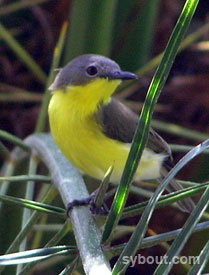
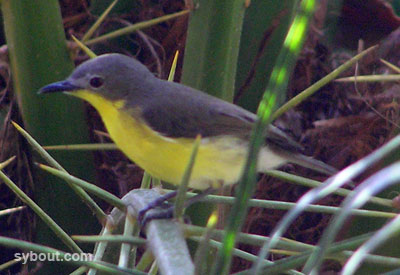
The flyeater is a tiny bird that usually is
first discovered by its distinctive song existing of a series of
tones descending three or four notes. This fast moving bird
basically lives on insects. In many areas in Indonesia its status is
common.
It makes a very attractive ball shaped nest hanging a few
meters above the ground. The round entrance made at the side is
covered with a little roof. It looks like a "tail" at bottom of nest
is sticking out in the opposite direction of the entrance to keep
the hanging construction in balance. Unfortunately I have no
pictures of a nest yet.
Grey-sided Flowerpecker
Latin: Dicaeum celebicum
Family: Dicaeidae
Indonesian: Cabai panggul-kelabu
Size: 9 cm
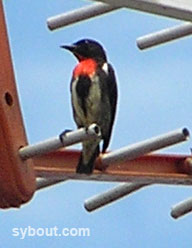
The quality of the picture above here is rather poor, but still I am
happy that it shows the bright red throat of this little bird. With
only 9 cm the Flowerpecker is the smallest birds visiting my garden.
Usually the Flowerpecker sits in a tree top or antenna and rarely visits lower
levels of the garden. Its high and fragile sound is difficult to
describe, but easy to recognise again once you know it.
Black-naped Oriole
Latin: Oriolus Chinensis
Family: Oriolidae
Indonesian: Kepudang Kuduk-hitam
Size: 26 - 30 cm
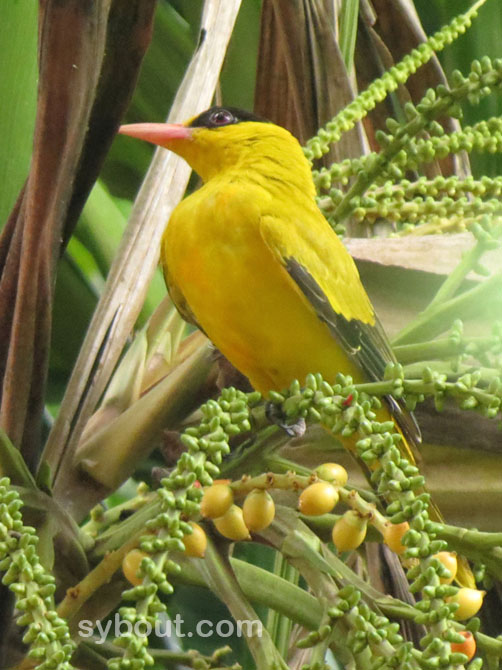
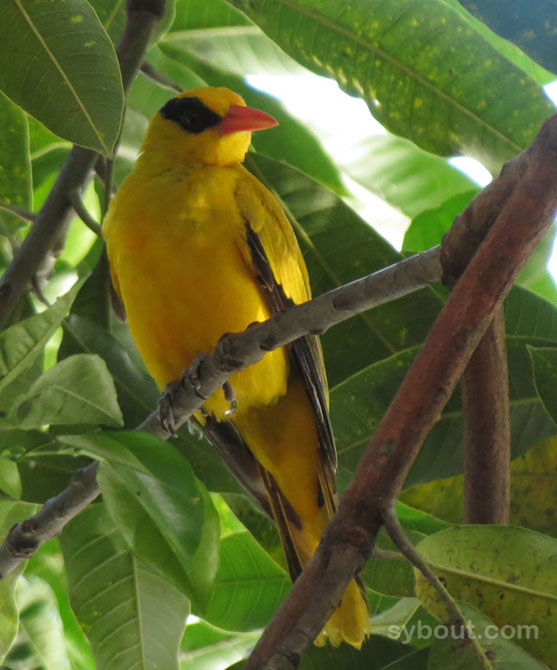
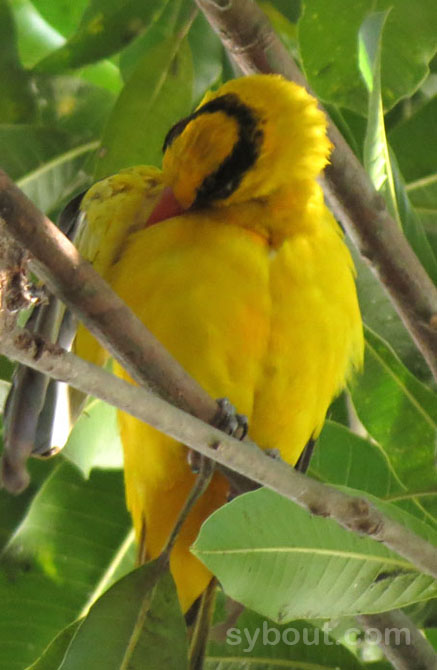
In the last months of 2020 the Black-naped Oriole was a regular guest in my garden. The first time I noticed it was when the mango tree had ripe
fruits. After these were finished (and harvested) it came for the fruits of the
MacArthur Palm. As this palm bears fruit all year round, I expected that the oriole would stay around.
Unfortunately it disappeared.
The oriole can easily be recognised by its bright yellow color, black mask and black ends of its wings and tail.
The Black-naped Oriole is bit bigger in size than the Sooty-headed Bulbul.
Its song is a short flute-like four-note melody that is repeated several times. It sometimes has as well a more nasal sounding call.
White-vented Myna
Latin: Acridotheres cinereus
Family: Sturnidae
Indonesian: Kerak Kerbau
English: White-vented Myna
Size: 25 - 26 cm
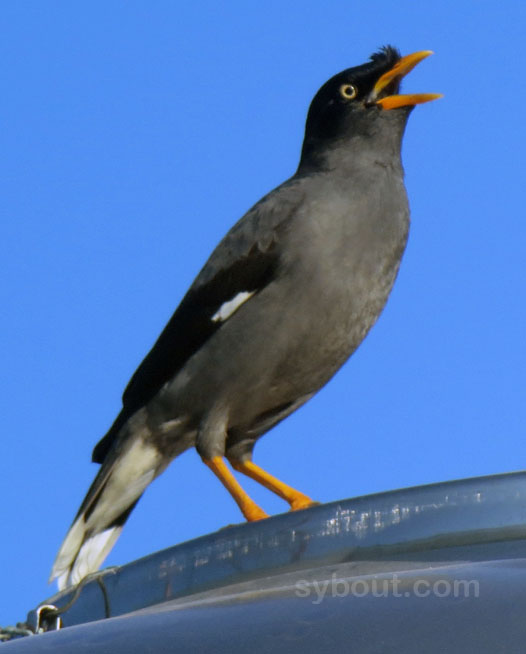
It was somewhere in 2016 that I saw for the first time White-vented Mynas around my house. First in 2020 these birds started visiting my garden to eat the berries of the MacArthur Palms. The birds usually move around in groups of about 4 - 5. In their flight the white parts of the wings are clearly visible. From a distance sitting birds look completely black, but nearby and with good lighting, the grey breast will be clearly visible.